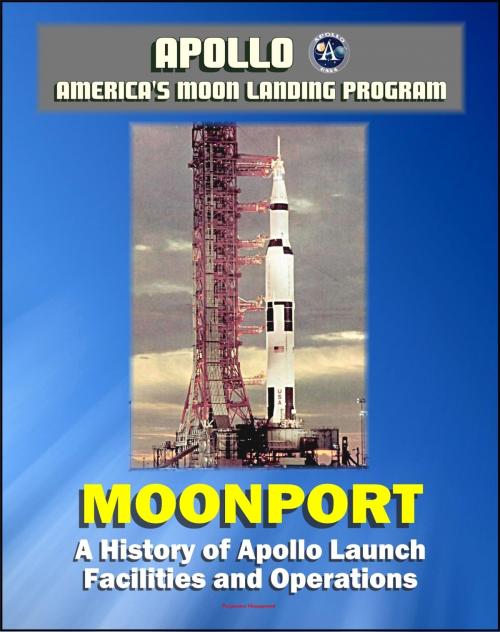Apollo and America's Moon Landing Program - Moonport: A History of Apollo Launch Facilities and Operations - Saturn 1, Saturn 1B, and Saturn V Rocket Launch Pads, Launch Complex 39 (NASA SP-4204)
Nonfiction, Science & Nature, Science, Physics, Astronomy, History, Americas| Author: | Progressive Management | ISBN: | 9781465907721 |
| Publisher: | Progressive Management | Publication: | November 15, 2011 |
| Imprint: | Smashwords Edition | Language: | English |
| Author: | Progressive Management |
| ISBN: | 9781465907721 |
| Publisher: | Progressive Management |
| Publication: | November 15, 2011 |
| Imprint: | Smashwords Edition |
| Language: | English |
This official NASA history document - converted for accurate flowing-text e-book format reproduction - is an superb review of the incredible launch facilities, including Launch Complex 39, built for the Apollo moon landing program in the 1960s at Kennedy Space Center in Florida.
The preface states: " Intense effort by a rapidly growing team of people in government, industry, and the universities gradually filled in the grand design and answered those questions. Land was acquired, ground was broken, pipe was laid, concrete was poured, buildings rose. When the launch vehicles and spacecraft arrived, the facilities were ready and operations could begin. Seldom was the pressure off or the path smooth, but the end of the decade saw the deadline met, the task accomplished. This history tells the story of the Apollo launch facilities and launch operations from the beginning of design through the final launch. You will meet many of the cast of thousands who took part in the great adventure. You will read of the management techniques used to control so vast an undertaking, of innovation in automation, of elaborate, repetitive, exhaustive testing on the ground to avoid failures in space. You will also learn something of the impact of the Apollo program on the citrus groves and quiet beaches of Florida's east coast.
The central feature of this book is launch complex 39 (LC-39), where American astronauts were launched toward the moon. Its story begins in early 1961 with the earliest plans for a mobile launch complex and proceeds through design and construction to the launching of Apollo 11 and subsequent lunar missions. The construction story is a big one - the building of the Apollo Launch facilities was the largest project of its lime. In many ways, however, the operations at LC-39 were an even greater challenge. As an Apollo program manager has noted, the Kennedy Space Center was at the "tail end of the whip." There all the parts of the Apollo program came together for the first time. The launch team ensured that the space vehicle would work.
White LC-39 is the principal focal point, it is not the only one. Two other Apollo-Saturn complexes on Cape Canaveral, LC-34 and LC-37, launched the program's early flights; at LC-34 the program's great tragedy occurred. The Apollo spacecraft were tested in the operations and checkout building in the Merritt Island industrial area. Vital telemetry equipment was located nearby in the central instrumentation facility. Moreover, the size and shape of the launch facilities were largely determined by the Saturn family of launch vehicles, which were produced under the direction of Marshall Space Flight Center at Huntsville, and by the Apollo spacecraft, under the Manned Spacecraft Center at Houston. An understanding of launch facilities and operations requires, to some degree, an appreciation of program-wide activities.
The history is complicated because planning, construction, and launch operations were conducted concurrently during much of the program. Three topics take up most of the first ten chapters: the construction of launch complexes 34 and 37 and the subsequent Saturn I tests; the planning of a moonport on Merritt island and the purchase of that area; and the buildup of the launch team. Chapters 11-15 relate the design, construction, and activation of launch complex 39, Chapters 16-23 describe the Apollo launch operations from early 1966 through the launch of Apollo 17 in December 1972. Chapter 24 is a tentative summing-up.
This official NASA history document - converted for accurate flowing-text e-book format reproduction - is an superb review of the incredible launch facilities, including Launch Complex 39, built for the Apollo moon landing program in the 1960s at Kennedy Space Center in Florida.
The preface states: " Intense effort by a rapidly growing team of people in government, industry, and the universities gradually filled in the grand design and answered those questions. Land was acquired, ground was broken, pipe was laid, concrete was poured, buildings rose. When the launch vehicles and spacecraft arrived, the facilities were ready and operations could begin. Seldom was the pressure off or the path smooth, but the end of the decade saw the deadline met, the task accomplished. This history tells the story of the Apollo launch facilities and launch operations from the beginning of design through the final launch. You will meet many of the cast of thousands who took part in the great adventure. You will read of the management techniques used to control so vast an undertaking, of innovation in automation, of elaborate, repetitive, exhaustive testing on the ground to avoid failures in space. You will also learn something of the impact of the Apollo program on the citrus groves and quiet beaches of Florida's east coast.
The central feature of this book is launch complex 39 (LC-39), where American astronauts were launched toward the moon. Its story begins in early 1961 with the earliest plans for a mobile launch complex and proceeds through design and construction to the launching of Apollo 11 and subsequent lunar missions. The construction story is a big one - the building of the Apollo Launch facilities was the largest project of its lime. In many ways, however, the operations at LC-39 were an even greater challenge. As an Apollo program manager has noted, the Kennedy Space Center was at the "tail end of the whip." There all the parts of the Apollo program came together for the first time. The launch team ensured that the space vehicle would work.
White LC-39 is the principal focal point, it is not the only one. Two other Apollo-Saturn complexes on Cape Canaveral, LC-34 and LC-37, launched the program's early flights; at LC-34 the program's great tragedy occurred. The Apollo spacecraft were tested in the operations and checkout building in the Merritt Island industrial area. Vital telemetry equipment was located nearby in the central instrumentation facility. Moreover, the size and shape of the launch facilities were largely determined by the Saturn family of launch vehicles, which were produced under the direction of Marshall Space Flight Center at Huntsville, and by the Apollo spacecraft, under the Manned Spacecraft Center at Houston. An understanding of launch facilities and operations requires, to some degree, an appreciation of program-wide activities.
The history is complicated because planning, construction, and launch operations were conducted concurrently during much of the program. Three topics take up most of the first ten chapters: the construction of launch complexes 34 and 37 and the subsequent Saturn I tests; the planning of a moonport on Merritt island and the purchase of that area; and the buildup of the launch team. Chapters 11-15 relate the design, construction, and activation of launch complex 39, Chapters 16-23 describe the Apollo launch operations from early 1966 through the launch of Apollo 17 in December 1972. Chapter 24 is a tentative summing-up.















